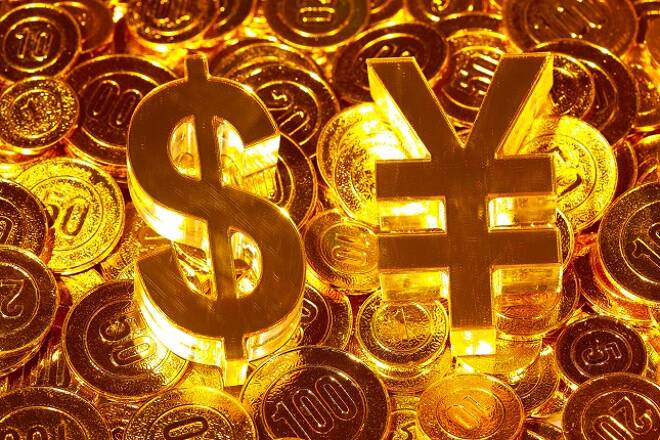Advertisement
Advertisement
Trade War Talk Drives Demand for the Yen, as Investors Run for Cover
By:
The rising prospects of a trade war saw equity markets tumble through the Asian session, with demand for the Yen on the rise, as the markets continued to respond to trade tariffs, which has left the Dollar on the back foot. Risk aversion will provide support for the EUR, while the Pound will be in the hands of the Euro Summit.
Earlier in the Day:
Economic data released through the Asian session was limited to Japan’s February national inflation figures, with core inflation hitting 1%, the most marked increase in core consumer prices since the summer of 2014.
The Japanese Yen moved from ¥104.681 to ¥104.877 upon release of the figures, before recovering to ¥104.76 at the time of writing, an intraday gain of 0.49%.
Rising prospects of a trade war saw demand for the Yen pickup through the U.S session and the Asian session this morning, with the Asian equity markets following the U.S and European markets deep into the red, as Trump order levies on at least $50bn of Chinese goods imported into the U.S.
Yen strength added further pressure to the Nikkei this morning, which was down 4.37% at the time of writing, with the CSI300 and Hang Seng also on the slide, as investors run for cover ahead of punitive trade tariffs being imposed on China exports to the U.S. For the ASX200, there was nowhere to hide, even with Trump having talked up the prospects of more favourable trade terms with Australia, as mining and resource stocks tumbled, Australian trade terms with China likely to be hit hard by tariffs that would temper demand for Chinese goods. The ASX200 closed out the day down 1.96%.
In spite of the risk off sentiment, the Aussie Dollar was on the rise through the morning, up 0.25% to $0.7712 at the time of writing, with the Kiwi Dollar up 0.21% to $0.7222, a jump in commodity prices supporting the pair. Trump’s continued realignment of the administration added further pressure on the U.S Dollar, providing further upside for the Aussie Dollar and Kiwi Dollar through the session.
The Day Ahead:
There are no material stats scheduled for release from the Eurozone this morning, to provide direction for the EUR, with the markets now looking for confirmation of the EU’s exemption on steel and aluminium trade tariffs. With trade tariffs on steel and aluminium kicking in today, the EU has been hard at work to gain exemption.
Direction for the EUR through the day will be hinged on market risk appetite and whether a formal announcement of the EU’s exemption will be made later this morning, with the risk off sentiment seeing demand for the EUR on the rise through the early part of the day.
EU heads of state will be at the Euro Summit through the day, though much of the focus, from a market perspective, will be on Brexit, assuming the exemption comes through.
At the time of writing, the EUR was up 0.26% to $1.2334.
For the Pound, after Thursday’s monetary policy decision that saw two members of the MPC vote in favour of a rate hike, raising the prospects of a May hike, direction through the day will be hinged on updates from the Euro Summit, where more details on a redrafted Brexit Treaty are expected that should give greater clarity on Britain’s exit from the EU. There are no material stats scheduled for release this morning to influence sentiment through the day.
The Pound was up 0.11% to $1.4112 at the time of writing, supported by Dollar weakness. Interestingly, the EU’s lobbying to gain exemption from trade tariffs on the basis of being long standing allies ought to be food for thought for member states and the Establishment, who have been looking to strong arm Britain during negotiations.
Across the Pond, economic data out of the U.S includes February’s durable goods orders and new home sales, which are unlikely to have a material impact on the Dollar, as the markets continue to respond to the trade tariffs being slapped on China and Trump’s replacement of key members of the administration.
FOMC voting members Kashkari and Dudley are scheduled to speak this afternoon, which could provide further pressure on the Dollar, should there be any chatter on the negative effects of a trade war on the U.S economy.
At the time of writing, the Dollar Spot Index was down 0.27% to 89.612, with a jump in demand for U.S Treasuries, seeing 10-year Treasury yields fall back to 2.81%.
Across the border, the Loonie has finally found some support, with rising oil prices and hopes of a more favourable outcome to NAFTA negotiations supporting the morning’s 0.19% gain to C$1.2914 against the U.S Dollar.
February inflation and January retail sales figures scheduled for release this afternoon will provide further direction for the Loonie, forecasts skewed to the positive.
About the Author
Bob Masonauthor
With over 28 years of experience in the financial industry, Bob has worked with various global rating agencies and multinational banks. Currently he is covering currencies, commodities, alternative asset classes and global equities, focusing mostly on European and Asian markets.
Advertisement
